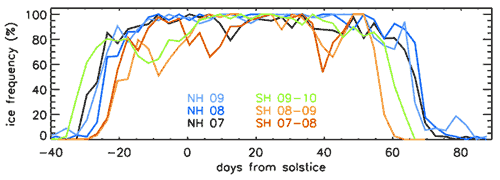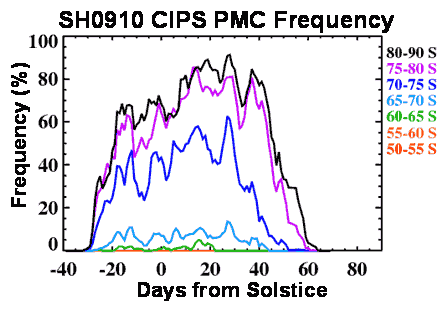|
STATUS:
03.08.10
Spacecraft Status
We have completed the Southern Hemisphere science season and our AIM spacecraft continues to function well with the usual intermediate periods of bitlock. On January 19, 2010 we completed 1,000 days of on-orbit operations and it continues to be quite the ride. The CIPS February Flat Field calibrations were performed February 24 through 27. The March Northern Hemisphere Flat Field calibrations are scheduled for March 24 through 27. The loads are currently in the queue and awaiting bitlock.
Instrument Status
SOFIE autonomy flight software modification has been uploaded to the instrument. This modification compensates for the variation between sunset and sunrise event start times caused by changes in beta angle. On-orbit testing of the modified flight software will take place in April 2010. Otherwise the instrument and payload operations remain unchanged with all engineering parameters well within tolerance.
SOFIE recently completed observations of the 2009-2010 Southern Hemisphere (SH) PMC season, giving a total of six PMC seasons observed to date. The figure below show time series of ice occurrence frequency for the six PMC seasons. Notice that the 2009-2010 SH season began ~10 days before the other SH season, and in fact prior to any of the three NH seasons. This dramatic difference is currently linked to both colder temperatures (compared to other SH seasons) and higher water vapor (compare to all NH and SH seasons).

CIPS continues to operate nominally; the last clouds of the SH 2009-2010 season were observed on 20 February. We have been able to acquire calibration data each month of the SH 2009-2010 season, resulting in better statistics than we’ve had for previous seasons. We are currently working on two new versions of the retrievals. The first, v3.22, represents an incremental advance in which we have determined new cloud detection thresholds so that cloud frequencies from season to season can be more accurately compared. We have completed processing two seasons with the v3.22 code; processing for all seasons should be complete by 1 April. The second new retrieval, version 4, includes a new approach to the background subtraction, enabling more accurate separation of cloud and Rayleigh scattering. Processing of the v4 data will begin after v3.22 is completed.
The figure here shows the daily PMC frequency as a function of latitude throughout the SH 2009-2010 season.

|
